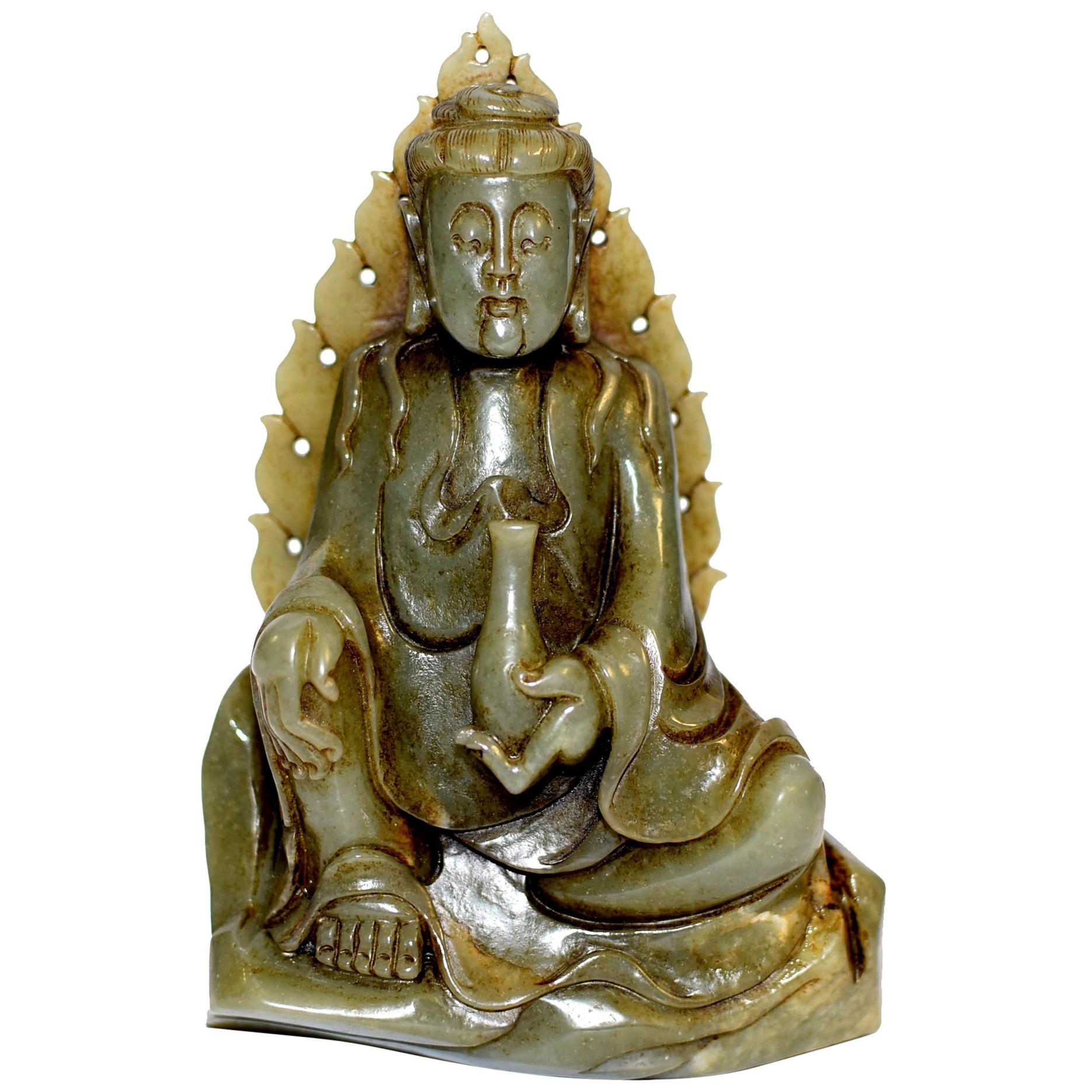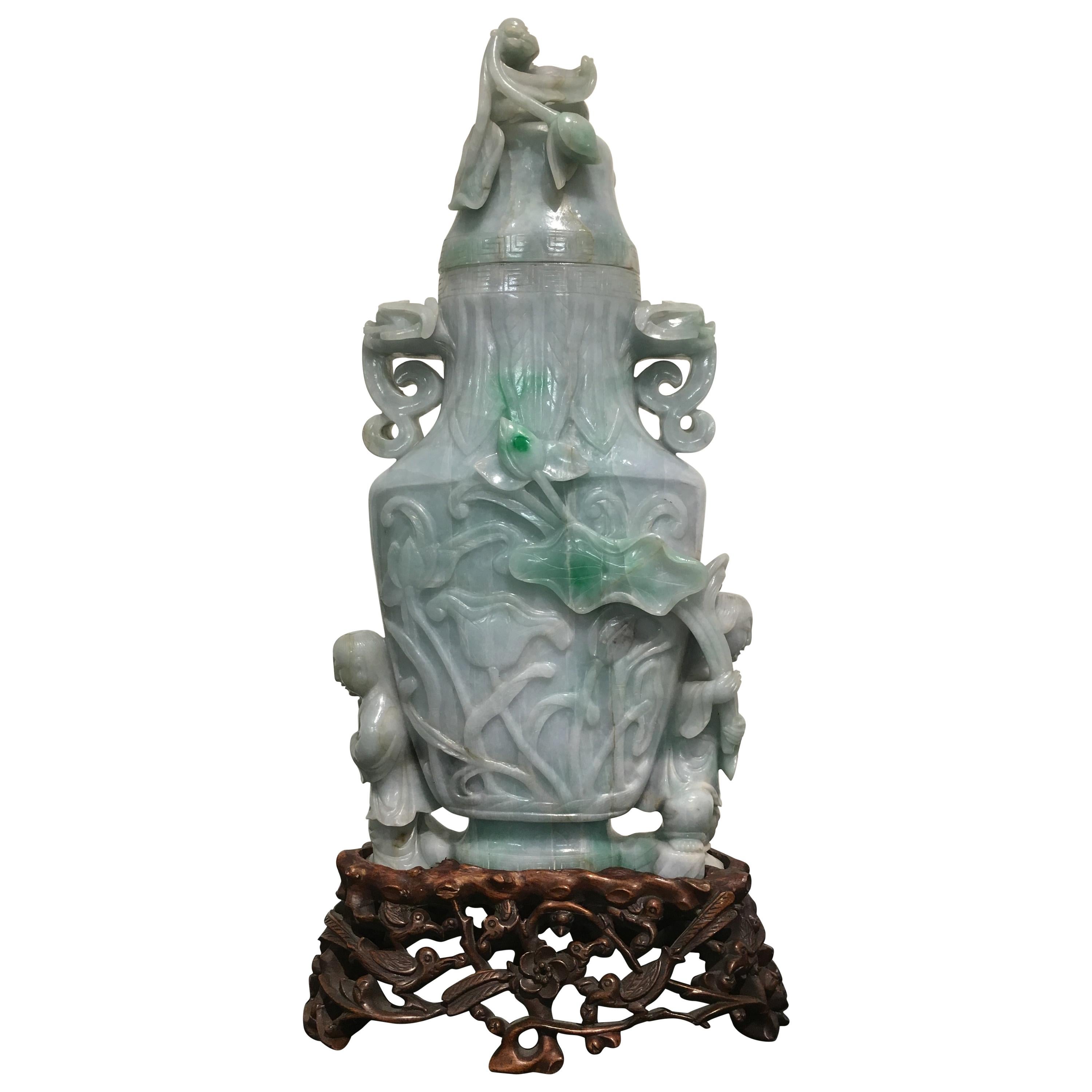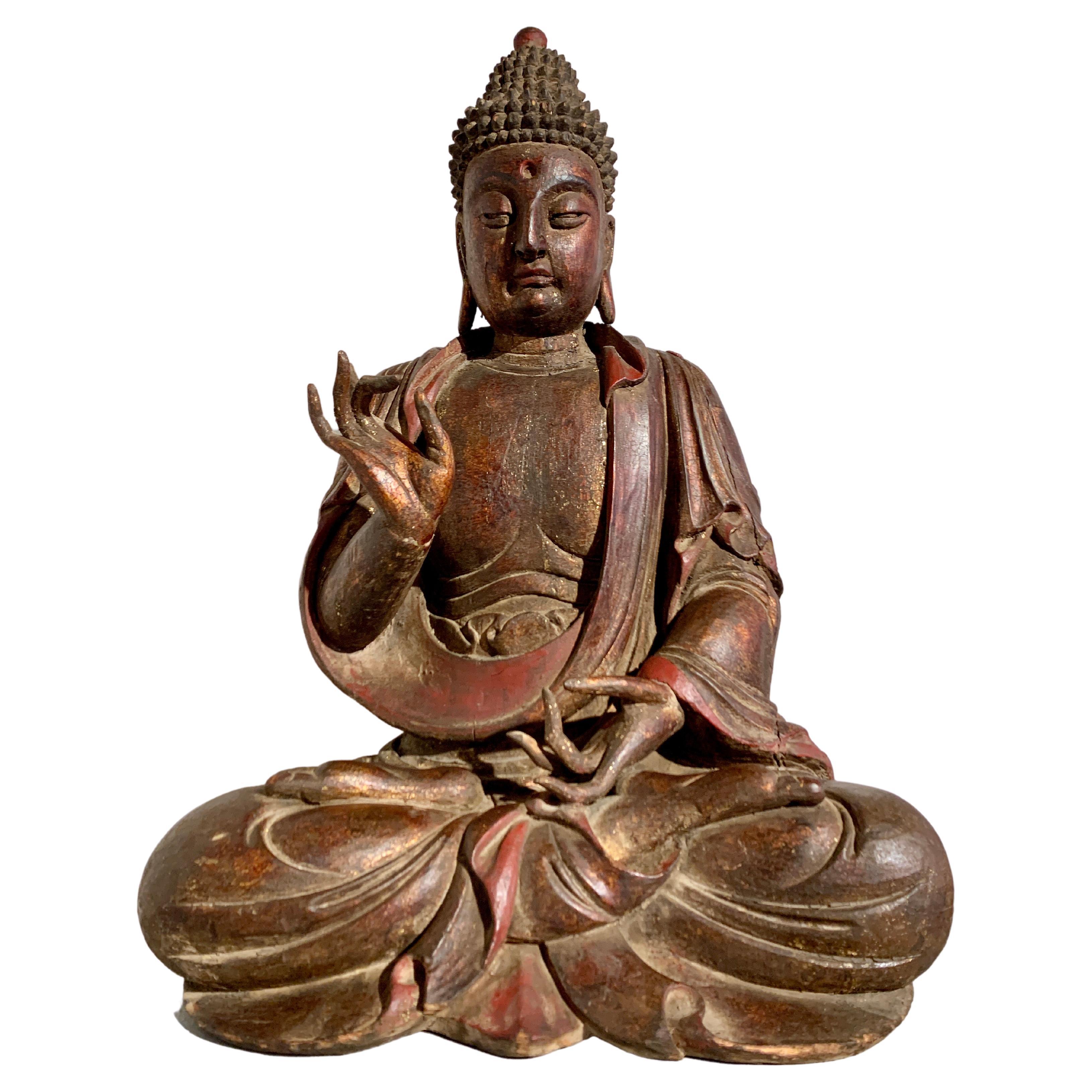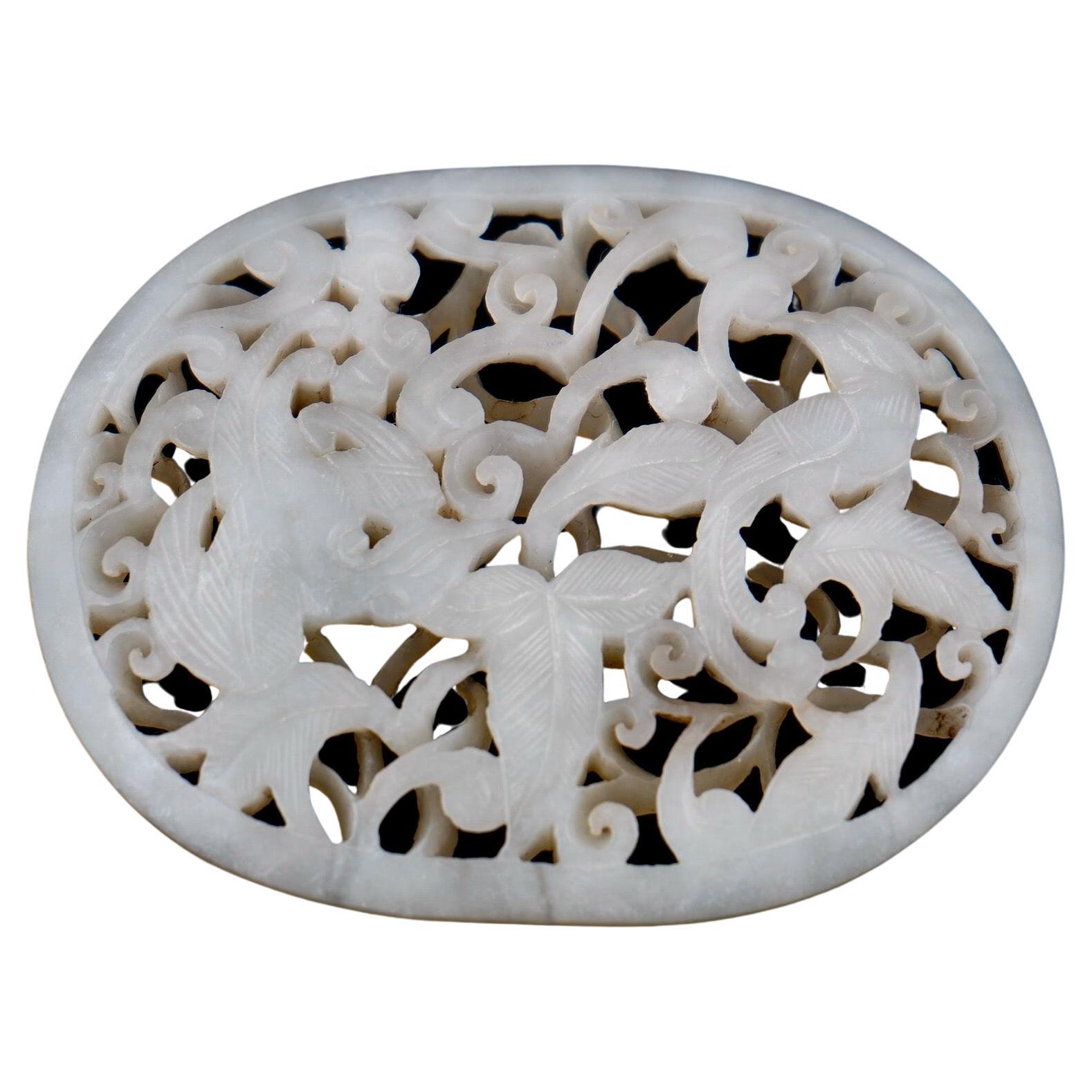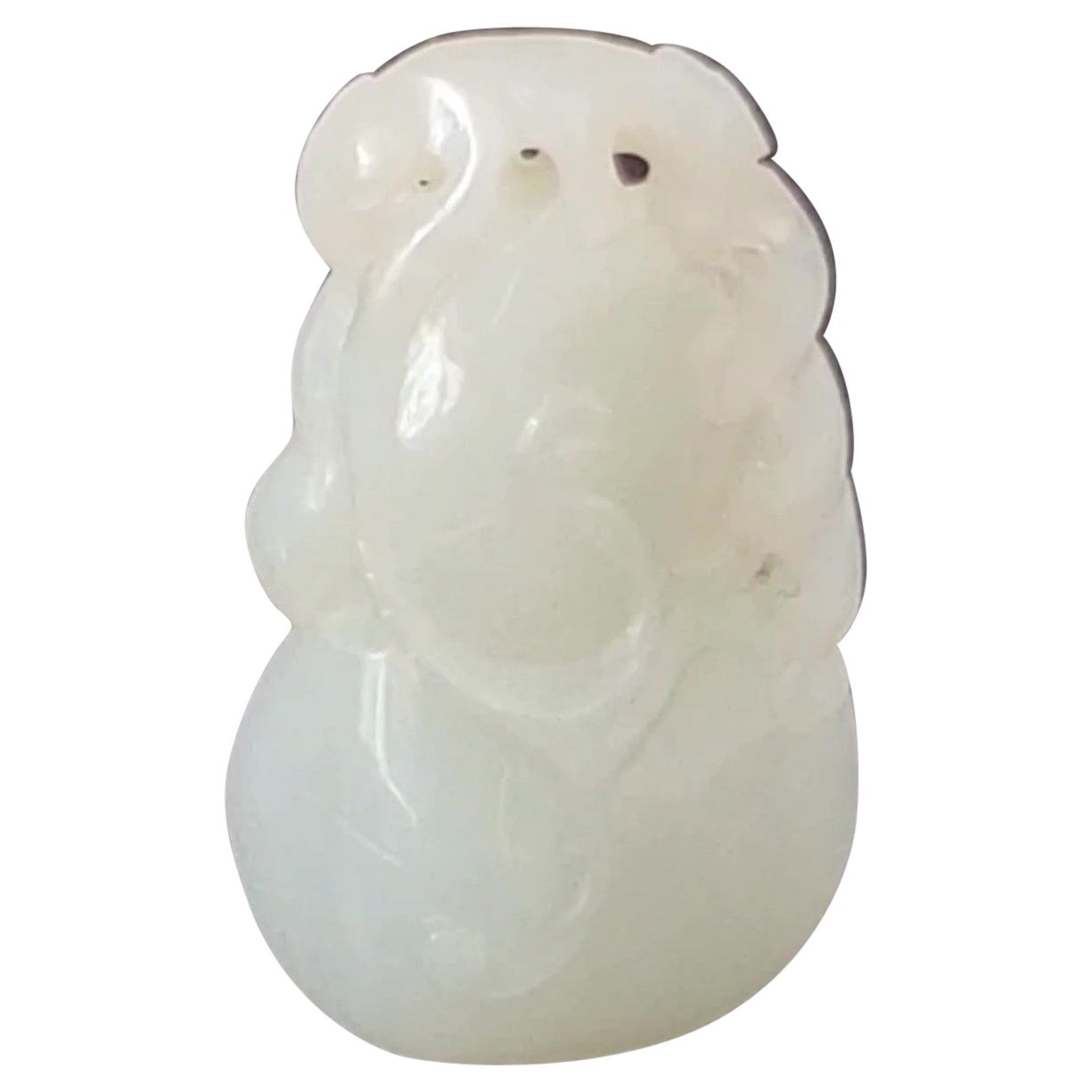Items Similar to Large Chinese Carved Nephrite Jade Double Buddha's Hand Vase, Late Qing Dynasty
Want more images or videos?
Request additional images or videos from the seller
1 of 19
Large Chinese Carved Nephrite Jade Double Buddha's Hand Vase, Late Qing Dynasty
About the Item
A large and graceful carved nephrite jade conjoined double vase in the form of a pair of Buddha's hands fruit (finger citron), late Qing Dynasty, circa 1900, China.
The large and heavy vase carved from a single piece of celadon nephrite jade, with areas of lighter brown "sugar" skin. The vase ingeniously carved as a pair of Buddha's hand fruit, also known as finger citron, rising from a gnarled, leafy branch. The smaller Buddha's hand with a pair of bats. The Buddha's hands fruit with elegant and naturalistic curved "fingers". The "fingers wonderfully shaped and reticulated. The body of the fruit with simple stippling, in imitation of the textured surface of the real fruit. The interior of each fruit well hollowed and able to hold water.
Buddha's hands fruit are auspicious in Chinese culture. Their name in Chinese "Fo Shou" is a homophone for "Happiness and Longevity. They are often placed as offerings on Buddhist altars. Bats are also a homophone for the word "Happiness".
- Dimensions:Height: 8.75 in (22.23 cm)Width: 6.25 in (15.88 cm)Depth: 3.5 in (8.89 cm)
- Style:Qing (Of the Period)
- Materials and Techniques:
- Place of Origin:
- Period:1900-1909
- Date of Manufacture:circa 1900
- Condition:Wear consistent with age and use. No chips, cracks or repairs noted. Some dirt accretions in the recessed areas.
- Seller Location:Austin, TX
- Reference Number:1stDibs: LU894723414802
About the Seller
5.0
Platinum Seller
These expertly vetted sellers are 1stDibs' most experienced sellers and are rated highest by our customers.
Established in 2001
1stDibs seller since 2010
306 sales on 1stDibs
Typical response time: 1 hour
- ShippingRetrieving quote...Ships From: Austin, TX
- Return PolicyA return for this item may be initiated within 7 days of delivery.
More From This SellerView All
- Large Early 20th Century Chinese Carved Jade VaseLocated in Austin, TXA large and impressive Chinese caved jade vase, Republic Period, circa 1930. Carved from one massive piece of jade. The vase carved with the He He Er Xian...Category
Early 20th Century Chinese Qing Sculptures and Carvings
MaterialsJade
- Large Chinese Carved and Lacquered Buddha, Qing Dynasty, 19th CenturyLocated in Austin, TXA large and magnificent near life-sized Chinese carved and lacquered wood figure of a Buddha, Qing Dynasty, 19th century or earlier, southern China. The figure likely represents one of the Five Tathagatas, also known as Dhyani Buddhas or Wisdom Buddhas. More specifically, either Amitabha or Amoghasiddhi. Amitabha is the Buddha of infinite light, and represents the wisdom of observation and recognition. Amoghasiddhi is the Buddha of accomplishment, and represents the wisdom of perfected practices. The size and scale of the Buddha indicates it was made for temple worship. The large Buddha is portrayed seated in vajrasana, or full lotus position, with the soles of both feet facing up. His elegant hands, with impossibly long and slender fingers, perform shuni mudra, the gesture of bestowing patience. His right arm is bent at the elbow, the right hand raised to heart level. The left arm resting gently in his lap, the left hand at navel level. The Buddha is dressed in voluminous robes that wrap around his shoulders and body, and tied at the waist. The heavy fabric draping and pooling elegantly all around his robust body. His broad chest and right arm exposed. The Buddha's face is both solemn and beatific - his expression seeming to change depending on the angle of view. The most notable feature of his face is the large urna to the center of his forehead, set between a pair of painted, high arching brows over heavily lidded almond shaped eyes. A strong nose is set above a small mouth pursed in an ever so slight smile. Long pendulous earlobes touch his shoulders. The Buddha's hair arranged in the typical fashion, with "spikes" representing tight curls. A prominent ushnisha rises from the crown of his head, covered by more hair, and topped with a rounded protuberance. The Buddha is constructed from several blocks of wood, joined, carved and lacquered a deep red-brown with gold flecks...Category
Antique 19th Century Chinese Qing Sculptures and Carvings
MaterialsWood
- Large Late Qing Dynasty Chinese Cast Bronze Buddhistic Foo Lion CenserLocated in Austin, TXA large and powerfully cast Chinese bronze censer in the form of two Buddhistic lions, Qing dynasty, late 19th century. The censer is well cast with a strong sense of movement, featuring a pair of fierce Buddhistic lions playfully antagonizing each other. Locked in a mock battle, the smaller lion...Category
Antique Late 19th Century Chinese Qing Sculptures and Carvings
MaterialsBronze
- Chinese Carved Zitan Figure of a Bodhisattva, Qing DynastyLocated in Austin, TXA finely carved Chinese zitan wood figure of an unidentified bodhisattva, possibly Guanyin, late Qing Dynasty, circa 1900, China. The androgynous figure has a plump, almost matronly face, with downcast eyes and a gentle smile. The hair in long tresses, gathered and tied in a high chignon. The enlightened being is portrayed seated in dhyanasana, bare feet resting on crossed legs, both soles pointing up. Thick robes billow and drape around the full figured body. The hands display...Category
Early 20th Century Chinese Qing Sculptures and Carvings
MaterialsLapis Lazuli
- Chinese Carved Boxwood Figure of Guanyin, Mid-Qing DynastyLocated in Austin, TXA sublime Chinese carved boxwood figure of the Bodhisattva of Compassion, Avalokiteshvara, called Guanyin in Chinese, mid-Qing dynasty. The an...Category
Antique Late 18th Century Chinese Qing Sculptures and Carvings
MaterialsBoxwood
- Chinese Bronze Fighting Foo Lions Censer, Qing Dynasty, Late 19th Century, ChinaLocated in Austin, TXA fantastic Chinese cast bronze censer in the form of two Buddhistic lions play fighting, late Qing Dynasty, late 19th century, China. The censer formed as a pair of Buddhistic li...Category
Antique Early 1900s Chinese Qing Sculptures and Carvings
MaterialsBronze
You May Also Like
- Antique Nephrite Jade Buddha Statue Qing DynastyLocated in Somis, CAA Qing dynasty, hand carved, lustrous, solid natural nephrite green jade Buddha. Carved seated on a rock against flame-shaped mandorla, the broad-faced figure rendered with a serene expression by downcast eyes beneath high arched brows above pursed lips, flanked by long pendulous ear lobes and beneath a pronounced hairline framing the forehead and hair gathered into a bun. Buddha holds a vase in the left hand while his right hand rests on the right knee. A long robe drapes gracefully pooling around the legs exposing the right foot. The prominent "y" shape formed by the strong nose and high brows is typical of 18th century Qian Long...Category
Antique 19th Century Chinese Sculptures and Carvings
MaterialsJade
- Chinese Jade Jadeite / Nephrite Pendant finely hand carved dragon, 19th C QingLocated in Lincoln, LincolnshireThis is a very good Chinese Jade, Jadeite / Nephrite stone pendant that we date to the early 19th Century, Qing period. The jade has various colours within the stone, mainly a very...Category
Antique 19th Century Chinese Qing Sculptures and Carvings
MaterialsJade
- Chinese White Jade Open Late Qing Dynasty PlaqueBy Alba ChinaLocated in Gainesville, FLChinese white jade openwork plaque late Qing Dynasty depicting birds and flowers. Very fine and detailed work. Small loss on the back side of the pl...Category
Antique 19th Century Chinese Chinese Export Sculptures and Carvings
MaterialsJade
- White Jade Double Gourd Pendant, Qing DynastyLocated in Nova Scotia, NSThis antique nephrite jade double gourd pendant is of the Qing Dynasty and has a fine texture with a glossy luster. It is primarily white with some slight inclusions in the left lower body but in bright light the pendant has a slight green tinge. This lovely jade pendant consists of a smaller gourd on top of a larger one surrounded by vines with smaller hanging gourds. The vines create numerous holes from which to hang the pendant. There are also etchings of stars on the body of the gourds along with tendrils of curling vines. In the Chinese culture, the double gourd is a symbol of fertility and good fortune. Gourds are also associated with Li Tie Guai, one of the eight immortals. This lovely jade pendant was purchased from a private collection along with a magnificent antique Chinese silk...Category
Antique 19th Century Chinese Qing Antiquities
MaterialsStone, Jade
- Antique Chinese Celadon Green Jade Carving, Triple Vase, Qing DynastyLocated in New York, NYAn extremely finely carved antique Chinese Qing dynasty, Celadon green triple vase/brush washer with an Imperial Dragon from behind attacking a bird in fro...Category
Antique 19th Century Chinese Qing Scholar's Objects
MaterialsJade
- Large Chinese Nephrite Jade Stone Sculpture Hand Carved Fine Art Dragons StatueLocated in Greer, SCStunning large Chinese hand carved genuine jade sculpture (tested as nephrite jade) depicting dragons and koi fish. The original owner provided details that this sculpture was create...Category
Antique Late 19th Century Chinese Qing Sculptures and Carvings
MaterialsJade
